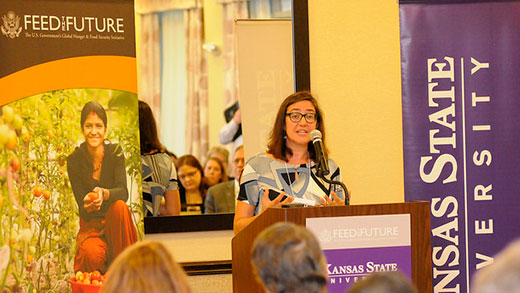
Jennifer ‘Vern’ Long, the acting director for the office of agriculture, research and policy in USAID’s Bureau of Food Security, says that awards like the $21.9 to three Kansas State University programs last week benefit U.S. farmers as much as helping combat hunger and poverty in under-developed nations.| Download this photo.
Good for the World, Good for Kansas
In helping to feed impoverished nations, K-State also is helping U.S. farmers
August 28, 2018
MANHATTAN, Kan. – Farmers in Kansas and across the United States stand to benefit as a result of last week’s announcement by the U.S. Agency for International Development that it has awarded $21.9 million to continue work to end global hunger and poverty through three Kansas State University programs.
During the annual Kansas Governor’s Summit on Agricultural Growth in Manhattan, USAID said it is awarding $14 million over five years for the Feed the Future Innovation Lab for Collaborative Research on Sorghum and Millet (SMIL); $3 million over three years for the Feed the Future Innovation Lab for the Reduction of Post-Harvest Loss (PHL); and $4.9 million over five years to the Feed the Future Innovation Lab for Applied Wheat Genomics.
All three of those programs were established at K-State in 2013. The new awards represent an extension of work the labs have been doing the past five years.
“These university programs, the innovation labs, are part of our implementation of Title XII of the Foreign Assistance Act, which mandates that these university programs provide dual benefits to both the U.S. and our developing country partners,” said Jennifer ‘Vern’ Long, the acting director for the office of agriculture, research and policy in USAID’s Bureau for Food Security.
“So it’s our intention from the outset to ensure that the focus of the research is not only to achieve our development goals of ending hunger and reducing poverty (globally), but also to ensure that we are delivering benefits to the U.S. as well.”
U.S. researchers proved this point with work done to provide resistance to the greenbug aphid in the 1980s. The pest infested U.S. sorghum fields, causing widespread losses, but research abroad allowed scientists to quickly implement host plant resistance, saving an estimated $389 million for U.S. producers – equivalent to $750 million in 2015 dollars.
K-State researchers also were directly involved in international efforts to develop wheat varieties that are resilient to heat and drought, as well as developing mitigation strategies to prevent the spread of aflatoxin in corn – a problem that could cost U.S. corn producers $1.67 billion in losses in bad years.
“We have a good track record through the innovation labs as a whole of safeguarding U.S. agriculture,” said Jagger Harvey, director of the PHL.
“Sometimes these are problems here in Kansas and the U.S., but it’s an issue season in and season out in the countries we’re working in,” Harvey said. “By working on the front lines, helping to give them a safer food supply so they can be healthier and really contribute to thriving economies, we can bring that back here to the U.S.”
Ernie Minton, the interim dean and director of the College of Agriculture and K-State Research and Extension, said that what the university’s innovation labs do is “important work.”
“It’s everything from the return of important germplasm to stimulating markets in under-developed countries,” Minton said. “I understand one of the measurable impacts has been an increase in exports to those countries. That’s one of those situations where all boats rise when we’re successful here at K-State.”
K-State has a fourth program, the Feed the Future Innovation Lab for Collaborative Research on Sustainable Intensification, which will be considered for renewal by USAID in 2019.
“All of these efforts lead back to the basic principal that U.S. universities serve their local communities in their home states and smallholder farmers halfway across the world,” Long said during last week’s announcement. “We think this model, where U.S. universities like Kansas State work closely with local constituencies to ensure that the work is relevant, is a model worth sharing.”
Learn more about USAID and the Feed the Future initiative at www.usaid.gov.
-30-
K‑State Research and Extension is a short name for the Kansas State University Agricultural Experiment Station and Cooperative Extension Service, a program designed to generate and distribute useful knowledge for the well‑being of Kansans. Supported by county, state, federal and private funds, the program has county Extension offices, experiment fields, area Extension offices and regional research centers statewide. Its headquarters is on the K‑State campus in Manhattan.
Story by:
Pat Melgares
785-532-1160
melgares@ksu.edu
For more information:
Kira Everhart-Valentin
785-532-6309
kevalentin@ksu.edu

